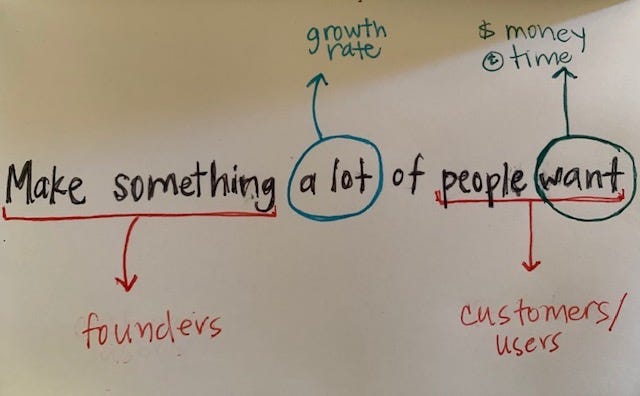How to Talk to Users
In Life and Startups
This is adapted from a talk I gave at Grace Hopper Celebration 2020 on Evaluating Startup Ideas. I deep dive into how to talk to users here.
“God gave you two ears and one mouth for a reason” is true in life and startups. In life, if we listened more and spoke less, how much more grace could we offer one another? And, if we offered more grace and kindness to one another (especially during this time), how many problems could be solved?
In startups, how many problems could be discovered if we spoke less and listened more to our users. You can’t offer solutions until you know what is the problem.
The founder’s mission is to make something a lot of people want.
This mission contains a problem (“people want”) and a solution (“make something”) [a]. Users own the problem, and the founder owns the solution. If you change ownership then you will end up at a dead end. If users own the solution, they will “ask for a faster horse”. If the founder owns the problem, you will end up with some of these (un) useless inventions:

Knowing who owns the problem and who owns the solution has large implications on how you talk to users and help you discover good problems to solve in the process.
“What People Want” (Finding the Problem)
👂Listening to Users
I spent my graduate work studying Human Computing Interaction. And one of the important exercises in design was to talk to users. The purpose of user design was to ensure usability. The purpose of talking to users for the founder is to ensure the problem. The founder needs to know what the problem is before they can solve it. The first cardinal rule in listening to users is:
You are not the the user. You are not the user. You are not the user.
Now that you have that mindset ingrained, the following will help you find the specific problem when talking to users [b]:
Avoid “would” questions.
Try to stay as close to what they are doing. It is so hard for even ourselves to predict what we would do in the future. Think about the last time you said you would purchase something if something changed or the price dropped. I’m sure you said “oh sure, especially for a friend”. But when the product launches, you never buy it and when asked why, you don’t really know.
People will tell you anything, but what they DO is more important.
We were creating a corporate social network when we founded the company. Eight months and 3 iterations later we only had about 1400 registered users and about 5 daily active users (which were likely our mothers), it did not take a math genius to know that the numbers showed a failed product. Each iteration we user tested and they said they loved us! They said they would use it! But when we launched, the numbers told a different story. They were well meaning, but that wasn’t their concern, it was ours. From that point on we realized, people will tell you anything, but what they do is more important.
Avoid talking about your solution.
In order to find as much as possible without influence, it would be better for you to not talk about what you are building. And, if you are very early on, avoid having them come up with a solution.
For example, if you want to build a better car, instead of asking “How would you make a faster car?”, you can ask “When was the last time you needed to get to some place faster? What did you do? Why did you need to get there?”
Otherwise, you will arrive at the same conclusion as Henry Ford, “If I asked my users what they wanted, they would say they want a faster horse” and render a useless solution.
But, what if you found that it wasn’t a better car that was needed? What if it was something bigger like a marketplace for private drivers (Uber) or a faster and better train (Hyperloop) ? If you asked specifically about the car, you would end up with a sub par problem which would result in a sub par solution.
Ask open ended questions.
When talking to users, the most important thing is talking less and listening more. The best way to listen more is to encourage users to talk more. Open ended questions do just that. Users can be specific or detailed about how they solved a problem. Questions that are not open ended lead to one word answers become too narrow, reducing the amount of information the user will tell you. Stick to questions that start with “What”, “How” or “Tell me about…”
Ask about the past.
Oftentimes we ask general questions like “What kinds of problems do you have with getting from place to place?”. And we’ll get general answers like “Well, sometimes I have problems parking or finding directions.” But you can miss so much. You need to get them to be specific as possible even about the process the better. The better way of getting specific would be to ask them to get specific: “Tell me about a time you had problems getting somewhere”. It is easier for people to recall rather than to talk in the abstract. They also can tell you more detail as it’s their experience and you can get very specific.
Ask them to show you.
This was one trick I learned when we built our fan communities on Facebook.
We had built one of the largest fan communities for TV shows and sports teams and we wanted to learn more about what our users liked and enjoyed. We used a software called Ethnio to recruit and talk to people in real time. This was a great experience because we were able to not only talk to users but have them show us on their computer. They would share their screens to us and we would ask them to show us how they navigated to a certain feature. We would ask them to show us how they navigated to our application. It was amazing learning more about our users. The biggest takeaway was something I never would have thought about which was the default screen space was much less than I imagined. One user even browsed with the bookmarks pane opened! This impacted our future designs.
Record, record record.
This is one thing founders and interviewers forget to do. In the past, you would take notes to record, and sometimes you would record them via a sterile user testing lab. But,now with Zoom it is quite easy to record the session. (Don’t forget to ask for permission from the user! )
And if you want an easy way to glean insights from the session without having to re-watch the whole session, you can use UserFocus that aggregates everything together to help you discover what exactly the problem your user has.
👂👪 Listening as a team (esp. if you have grumpy engineers 😜)
If want to listen as a team, make listening to users as part team building and part solution finding. You have everyone, product managers, engineers, customer support, participate in this exercise.
(1) Invite users to use your product in a user feedback session.
(2) Pair up team members. Have one ask questions trying to find either usability issues or problems. Refer to the above on types of questions to avoid and to ask. Have the other team member watch [b] and take notes on how the user does things.
(3) Debrief. After the user session is done, make sure you debrief with the team and leave ample room to allow everyone an opportunity to speak. You will be surprised how much everyone wants to share what they saw and learned.
We were launching our first game and we decided to have friends and family come in and test the game. It was the absolute worst user testing session I had ever been in. We had our friends walk through tasks and engaged in a focus group discussion afterwards. The game was confusing and our closest family members were saying how they would not play our game, even if we paid them. The more interesting thing happened afterwards, our quietest and grumpiest engineers all wanted to talk about what they saw and were offering solutions to fix the problems that some designers saw ahead of time.
We fixed what we could. There was a lot of confusion in the first time experience as well as chat was not fully functional. But, how we arrived at those fixes made our team dynamics better, and the solution was player-led rather than internally guessing and debating. That was the most valuable piece of listening to our players, is how it impacted us. In the end, we learned that players say one thing and do another. And, that family member who said they would never play even if we paid them …He became one of the highest ranked members in the game, without us paying him 😉
The above tips are great when you are going from zero to one versus when you are launched and looking at metrics. You will revisit the above tips as you discover qualitative information or if you ever interact directly with your customer. If you have several people talking to your customers, you can use User Focus as a way to see all the feedback in one place.
If your product has launched, and have data, read Designing for Dollars: how to link design with business goals and metrics.
Above all, launch, and once you do, to keep on launching.
🔦 Startup Spotlight 🔦
This post has been inspired by my friend, Prayag, who is building UserFocus. We used to lament how much founders did not know how to talk or listen to users. And, as the company grew, it was harder and harder to get these insights. He saw how this impacted his first business and set out to solve it with UserFocus.[d]
UserFocus makes it easier and faster to find and share insights from user interviews. User Interviews are your best source of product and market insights. To get the right insights you have to be methodical about the process of recording, analyzing, sharing and organizing user interviews. UserFocus helps you do just that. Integrating right inside your Zoom to help bring the right process and collaboration into your user interview process. If this post has inspired you to talk more to your users, you should definitely check them out!
They are in closed beta but are available to the readers of this newsletter. Just send them an email at prayag@userfocus.app and they can hook you up. Oh and it's free forever for the first 100 users from his network, so email him and join his network 😊!
📢 Announcements 📢
What’s a newsletter without some announcements?
YC Interview Season
The season continues! For founders this can be a stressful time. If you applied and did not get into YC, do not despair! (1) You can always apply again and (2) Almost half the batch has applied and been rejected before getting into the batch. Rejection is a part of the process, do not take it as a rejection of you.
For those that did get an interview, congratulations! I’m happy to do a mock YC interview with you, just sign up. Priority given to women and underrpresented founders.
❤️Sharing is caring. If you think anyone could benefit from this newsletter or post, please share! ❤️

